Biography
He studied at the Royal Academy of Fine Arts, with the history and portrait painter, Mattheus Ignatius van Bree. However, from the beginning, he chose to specialize in landscapes. Following his graduation, he made the traditional study trips throughout Western Europe; focusing on natural settings and largely avoiding visits to museums or other art schools. In 1825, he had his first exhibition in Antwerp; a landscape with a cow and shepherd in the foreground. From 1828, he exhibited annually in Brussels, Ghent and Antwerp.
Later, a career opportunity took him to Namur. A new Academy of Art was founded there in 1835, and teachers were sought. He applied for a position as landscape teacher, was chosen, and soon became Director of the landscape department. He remained in that position until 1882, when he retired and was succeeded by Louis Bonet [ fr ], one of his former students.
While there, he trained many notable landscape painters, such as Géo Bernier, Euphrosine Beernaert, Jean-Baptiste Kindermans [ fr ], Joseph Quinaux, François Roffiaen, and Armand Dandoy [ fr ]. Perhaps his most important student was Félicien Rops.
He was awarded a Silver Medal in 1837, by Royal Decree. From 1851 to 1854, he created a series of paintings, depicting local landmarks, for the Namur Provinciegebouw (provincial office building). in 1855, he was a co-founder of the "Société archéologique de Namur". He created another similar set of paintings, from 1871 to 1872, for the Hôtel Bequet. They are currently on display at the castle in Émines. Other decorative projects followed at the Hôtel Vercruysse in Kortrijk, and a castle in Rhisnes.
In 2007, his first painting, of the cow and shepherd, was auctioned for €4,000.

The Meuse or Maas is a major European river, rising in France and flowing through Belgium and the Netherlands before draining into the North Sea from the Rhine–Meuse–Scheldt delta. It has a total length of 925 km.
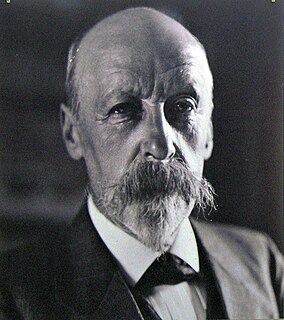
Emile Claus was a Belgian painter.

Jean François Xavier Roffiaen was a Belgian landscape painter who specialised in painting Alpine landscapes.
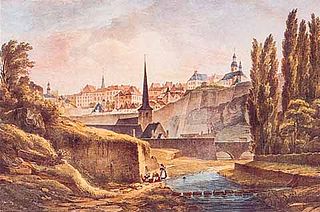
Jean-Baptiste Fresez (1800–1867) was Luxembourg's most important 19th-century painter. He is remembered above all for his almost photographic images of the City of Luxembourg.

Éliane Georgette Diane de Meuse was a Belgian painter. She was the wife of Max Van Dyck. They met at the Académie Royale des Beaux-Arts, Brussels where they attended the courses of the same professors.

Jan Baptiste de Jonghe or Jean-Baptiste de Jonghe was a Belgian painter, draughtsman, etcher and lithographer. He is known for his Romantic landscapes with people, herds and ruins. In his graphic work he also made views of cities in the area of what is now Belgium and the Netherlands. He was an art professor at the Academy of Kortrijk and the Antwerp Academy of Fine Arts.

Louis Dubois (1830-1880) was a Belgian painter who specialized in landscapes and portraits in a naturalistic style. He also painted genre and still-life subjects.

Évariste Carpentier was a Belgian painter of genre scenes and animated landscapes. Over the years, his painting evolved from academic art to impressionism. Alongside Emile Claus, he is one of the earliest representatives of luminism in Belgium.
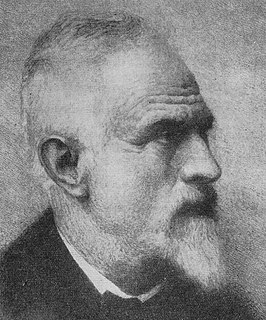
Théodore Baron was a Belgian landscape painter in the Realistic style.

Louis Victor Antonio Artan de Saint-Martin was a Dutch-Belgian painter and etcher who specialized in seascapes.
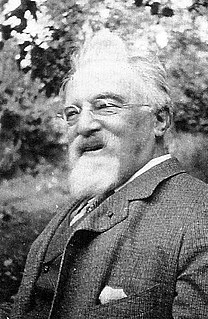
Adriaan Jozef Heymans was a Belgian impressionist landscape painter.

Victor Gilsoul (1867–1939) was a Belgian impressionist, luminist and painter who worked mostly on commissions from the European nobility.

Gillis Neyts or Aegidius Neyts was a Flemish painter, draughtsman and engraver. He was a landscape artist who is now mainly known for his italianising and topographical drawings of sites throughout the Southern Netherlands. He was a less prolific painter of landscapes and also produced a number of landscape prints. He further left a great number of figure studies.

Jan Stobbaerts or Jan-Baptist Stobbaerts was a Belgian painter and printmaker. He is known for his scenes with animals, landscapes, genre scenes and portraits or artists. With his dark-brown studio tones and forceful depiction of trivial subjects, Stobbaerts was a pioneer of Realism and 'autochthonous' Impressionism in Belgium.

Xavier de Cock was a Belgian painter. He specialized in genre scenes and landscapes with animals.

Jules Lismonde was a Belgian painter and drawer. He was a member of the Royal Academy of Science, Letters and Fine Arts of Belgium.

Andreas Martin or Andreas Marten was a Flemish painter and draughtsman. He is known for his imaginary landscape paintings, topographical landscapes, cityscapes of Brussels and its environs and rural genre scenes. He lived and worked in Brussels.

Alphonse Asselbergs was a Belgian painter; primarily of landscapes and forest scenes.
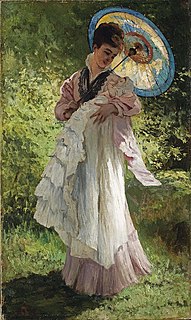
Camille van Camp was a Belgian portrait and landscape painter, watercolorist, and engraver.
This page is based on this
Wikipedia article Text is available under the
CC BY-SA 4.0 license; additional terms may apply.
Images, videos and audio are available under their respective licenses.




















